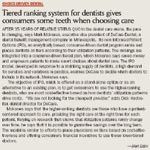Essential extras: Plans support dental and vision benefits that contribute to better health
Just like the rest of healthcare, dental and vision ancillary benefit providers are adopting cost-sharing strategies that offer options to employees but demand more skin in the game. With less financial responsibility on the shoulders of employers, ancillary benefits have become more flexible, varied and are more closely tied to the overall health of individuals, who are assuming more risk for their health.
Just like the rest of healthcare, dental and vision ancillary benefit providers are adopting cost-sharing strategies that offer options to employees but demand more skin in the game. With less financial responsibility on the shoulders of employers, ancillary benefits have become more flexible, varied and are more closely tied to the overall health of individuals, who are assuming more risk for their health.
Research studies have offered evidence that periodontal (gum) health is closely associated with better health overall, especially for those with heart and cardiovascular disease, diabetes, and for women who are pregnant. According to the Journal of the American Dental Association, there is a strong correlation between high blood sugar and periodontal disease in those with diabetes. In addition, a report from the Surgeon General shows that people with gum disease are at greater risk for heart disease and stroke.
For pregnant women with gingivitis, periodontal cleanings cut costs and premature births by as much as 84%, says the International Foundation of Employee Benefit Plans. As reported in the journal Stroke, those with severe periodontal disease have a risk of stroke more than four times greater than those with mild or no periodontal disease.
OUNCE OF PREVENTION Aetna Dental based in Hartford, Conn., conducted its own research in conjunction with Columbia University College of Dental Medicine and found that those with diabetes, coronary artery disease (CAD) and cardiovascular disease (CVD) who sought early periodontal treatment decreased their risk or severity of their condition. As a result, they lowered their overall medical costs: 9% for diabetes, 16% for CAD and 11% for CVD.

Subsequently, Aetna designed an enhanced benefit program for pregnant women, who have both Aetna medical and dental coverage, at no charge to plan sponsors and for those with diabetes, CAD and CVD for an additional charge. Not only will they receive postcards emphasizing the value of periodontal care and reminders to make appointments, but they also are fully covered (with no deductible) for one additional cleaning and scaling and root planing.
CIGNA Dental, headquartered in Plantation, Fla., has adopted a similar program. The Oral Health Integration Program targets members with diabetes and CVD who are enrolled in CIGNA's disease management programs. A program for pregnant women started in 2006.
"We wanted to remove the financial barrier and focus on those with specific high-risk conditions," says Miles Hall, chief clinical director. CIGNA Dental's benefits cover an additional cleaning per year and up to four periodontal maintenance visits a year for scaling and root planing. Hall says that CIGNA Dental is continually researching evidence-based dentistry in order to create new benefits that drive more preventive care.
"Employers are pressured to at least offer dental benefits on a voluntary basis," Hall continues, "although employees and plan members are more responsible for a greater share of the cost."
To address this trend, CIGNA has introduced two decision support tools-the Dental Plan Cost Estimator and the Dental Treatment Cost Estimator-which enable consumers to compare available dental benefits and costs and then estimate costs before services are rendered.
Chief Pharmacy Officer Jason R. Smith on the Challenges Health Systems Face
May 28th 2025Jason R. Smith, Pharm.D., appointed as chief pharmacy officer in February 2025 for the University of Rochester Medical Center, talks about building a stronger workforce, managing drug shortages and keeping up with changes in regulations because of the new administration.
Read More
Extending the Capabilities of the EHR Through Automation
August 2nd 2023Welcome back to another episode of "Tuning In to the C-Suite," where Briana Contreras, an editor of Managed Healthcare Executive, had the pleasure of chatting with Cindy Gaines, chief clinical transformation officer at Lumeon.
Listen